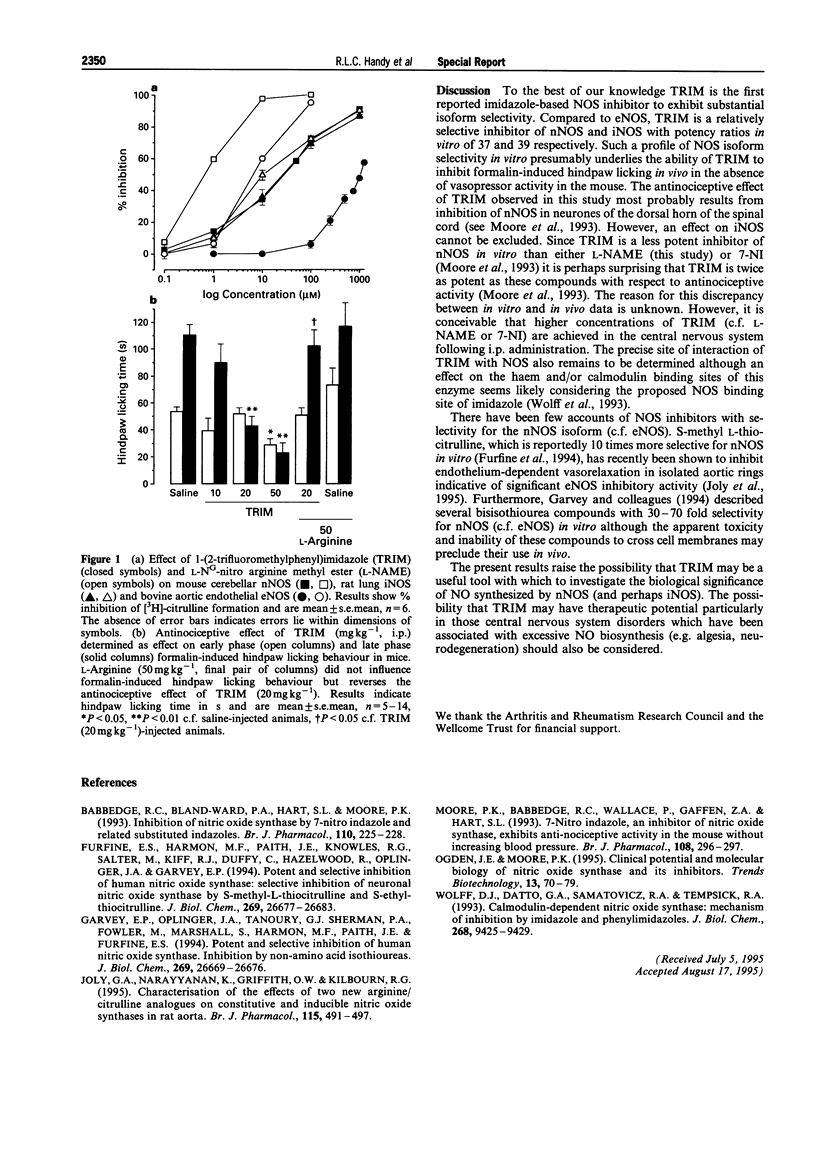Abstract
1-(2-trifluoromethylphenyl)imidazole (TRIM) is a potent inhibitor of neuronal (mouse cerebellar) and inducible (lung from endotoxin-pretreated rats) isoforms of nitric oxide synthase (NOS) with IC50 values of 28.2 microM and 27.0 microM, respectively. In contrast, TRIM is a poor inhibitor of bovine aortic endothelial NOS with an IC50 of 1057.5 microM. TRIM (10-50 mg kg-1) administered i.p. exhibits dose-related antinociceptive activity in the mouse (assessed as inhibition of late phase formalin-induced hindpaw licking behaviour) with an ED50 of 85.8 mumol kg-1. In contrast, TRIM (50 mg kg-1, i.p.) failed to influence mean arterial blood pressure in the urethane-anaesthetized mouse. Thus, TRIM may be of use as an experimental tool with which to investigate the biological roles of nitric oxide (NO) within the central nervous system.
Full text
PDF

Selected References
These references are in PubMed. This may not be the complete list of references from this article.
- Babbedge R. C., Bland-Ward P. A., Hart S. L., Moore P. K. Inhibition of rat cerebellar nitric oxide synthase by 7-nitro indazole and related substituted indazoles. Br J Pharmacol. 1993 Sep;110(1):225–228. doi: 10.1111/j.1476-5381.1993.tb13796.x. [DOI] [PMC free article] [PubMed] [Google Scholar]
- Furfine E. S., Harmon M. F., Paith J. E., Knowles R. G., Salter M., Kiff R. J., Duffy C., Hazelwood R., Oplinger J. A., Garvey E. P. Potent and selective inhibition of human nitric oxide synthases. Selective inhibition of neuronal nitric oxide synthase by S-methyl-L-thiocitrulline and S-ethyl-L-thiocitrulline. J Biol Chem. 1994 Oct 28;269(43):26677–26683. [PubMed] [Google Scholar]
- Garvey E. P., Oplinger J. A., Tanoury G. J., Sherman P. A., Fowler M., Marshall S., Harmon M. F., Paith J. E., Furfine E. S. Potent and selective inhibition of human nitric oxide synthases. Inhibition by non-amino acid isothioureas. J Biol Chem. 1994 Oct 28;269(43):26669–26676. [PubMed] [Google Scholar]
- Joly G. A., Narayanan K., Griffith O. W., Kilbourn R. G. Characterization of the effects of two new arginine/citrulline analogues on constitutive and inducible nitric oxide synthases in rat aorta. Br J Pharmacol. 1995 Jun;115(3):491–497. doi: 10.1111/j.1476-5381.1995.tb16360.x. [DOI] [PMC free article] [PubMed] [Google Scholar]
- Moore P. K., Babbedge R. C., Wallace P., Gaffen Z. A., Hart S. L. 7-Nitro indazole, an inhibitor of nitric oxide synthase, exhibits anti-nociceptive activity in the mouse without increasing blood pressure. Br J Pharmacol. 1993 Feb;108(2):296–297. doi: 10.1111/j.1476-5381.1993.tb12798.x. [DOI] [PMC free article] [PubMed] [Google Scholar]
- Ogden J. E., Moore P. K. Inhibition of nitric oxide synthase--potential for a novel class of therapeutic agent? Trends Biotechnol. 1995 Feb;13(2):70–78. doi: 10.1016/S0167-7799(00)88908-8. [DOI] [PubMed] [Google Scholar]
- Wolff D. J., Datto G. A., Samatovicz R. A., Tempsick R. A. Calmodulin-dependent nitric-oxide synthase. Mechanism of inhibition by imidazole and phenylimidazoles. J Biol Chem. 1993 May 5;268(13):9425–9429. [PubMed] [Google Scholar]


